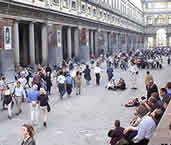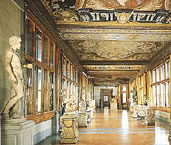Museo colaborador



|
Uffizi Gallery
|
National Museet |
|
Museo colaborador |
|
| The Uffizi Palace was built in 1560 by Duke
Cosimo I of the Medici family, who wanted to create a special seat for the
offices of 13 magistrates making up the administrative centre of the Florentine
State. The project was carried out by architect and painter Giorgio Vasari,
who had to include the San Pier Scheraggio church and the old Zecca. He
was succeeded by Buontalenti, who completed the building in 1581. In the
XVIIth century, the Medicis installed a large number of art works in newly
refurbished rooms on the second floor, which were opened to the public.
For this reason, the Uffizi Gallery can be considered as one of the first
museums in history. The last of the Medicis, Anna Maria Luisa, made an accord
with the city of Florence, which ensured that the family treasures would
permanently belong to the city. Today it is one of the most important museums
in the world, both for the number of works it holds as well as for their
great artistic value. |
|
 |
 |
 |
|